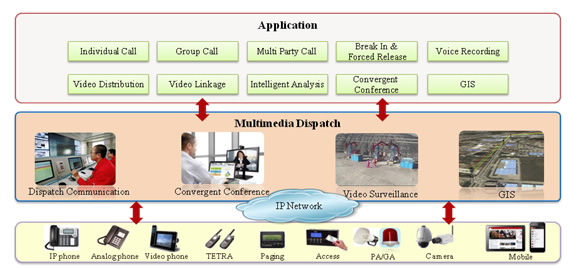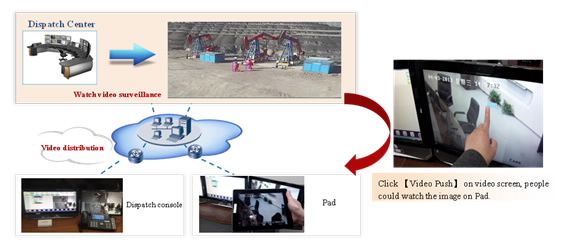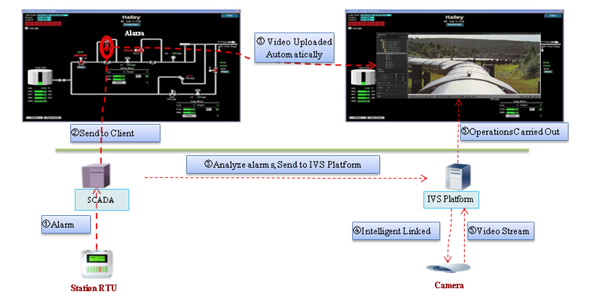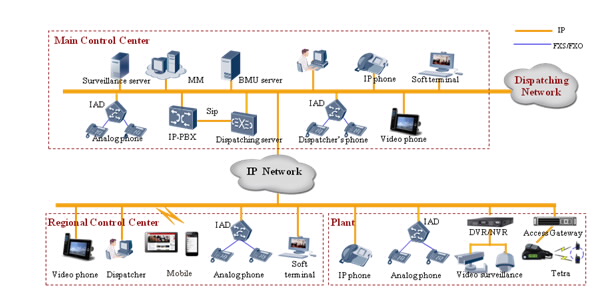Solución de envíos multimedia para empresas en las industria de gas y petróleo
The oil and gas industry is facing growing requirements for faster emergency-response,large-scale application management, and service expansion that traditional voice dispatch systems cannot meet. After a thorough analysis of industry requirements, Huawei has developed a state-of-the-art command and dispatch system that features an all-IP data network. This system provides rich dispatch functions that ensure efficient information transmission and convenient cross-regional communications.
For Partners
Most existing command and dispatch systems use phones and IP exchange technologies that cannot provide modern services, creating unique challenges at remote branches for protection and security personnel.
- Diverse operating systems for dispatching, conferencing, and communicating with HQ hamper inter-operability, management, and system maintenance
- Traditional service dispatch systems lack video surveillance and conferencing abilities, hindering the ability of management to make accurate decisions when remote command and dispatch are needed
- Public Switched Telephone Network (PSTN) dispatch systems are not compatible with newer technologies including VoIP, PC/tablet clients, mobile devices and instant messaging
- Having multiple systems incurs greater maintenance costs and limits the ability to integrate, extract, or analyze data via cross-system resource sharing
Huawei multimedia solutions reduce costs while connecting key personnel
Huawei’s multimedia dispatch solution for oil and gas companies includes these major components:
- Applications: point-to-point call, group call, barge, forced release, call recording, rights management, video distribution, video linkage, intelligent analysis, convergent conferencing, and GIS
- Multimedia dispatch: dispatch communications, convergent conferencing, video surveillance, and GSI platforms
- IP network: the infrastructure that connects all network elements
- Terminals: traditional phones, IP phones, video phones, intercom, access control, broadcasting system (microphone and speaker), camera, tablet, and smart phones
Diagram of Multimedia Solution Architecture

Make the right call with layered dispatch solutions
Huawei’s multimedia dispatch solution for oil and gas companies consists of three layers. Layer 1 is the dispatch center in the company headquarters. Layer 2 is dispatch departments in subsidiaries and branches. Layer 3 is dispatch systems in production units and relevant service departments, such as oil plants and refineries.
Each of these layers can be organized, coordinated, and managed by production level. In turn, administrators allocate rights to dispatchers according to their responsibilities. Dispatch departments then use touch-screen dispatch consoles and dispatcher phones to dispatch resources according to their pre-assigned rights. Consoles and dispatchers can be classified into a maximum of six levels (higher level dispatchers have more rights). Grouping consoles and dispatchers together provides the flexibility to:
- Have consoles in the same group to ring simultaneously so any user can select consoles to answer incoming calls
- Place phones on different sites in the same group to enable cross-regional dispatch
- Share information and collaborate with each other to process services. For example, consoles can be grouped based on work teams.
See it, send it, share it with video dispatching
In the Huawei’s multimedia dispatch solution, the dispatch system supports point-to-point video call and video forwarding. Dispatchers use the video-forwarding function to transfer video from dispatch consoles to terminals, such as a dispatcher forwarding a call from the console to a tablet to enable video surveillance.
Oil and gas companies can use the video command and dispatch system to immediately detect risks, collaborate in emergency response, and perform bi-directional video communication. By integrating video surveillance and conferencing systems, the solution enables video resource sharing and efficient incident processing.
Huawei’s convenient, convergent conference operation simplifies resource dispatch, as the solution supports unified conference management. The conference authentication function prevents unauthorized conference initiation or interruption, and allows authorized dispatchers to initiate convergent conferences (voice, video, and data) with simple mouse clicks.
Meanwhile, Huawei’s command and dispatch system uses advanced architecture to separate service and switching data. The system consists of four layers: service management, network control, core switch, and border access. This highly scalable system can connect to the clustering system, broadcasting system, GSM modem, and fax gateway, meeting industry demands for fast service deployment.
Diagram of Video Dispatching

The command and dispatch system is designed to link up with video surveillance platforms. When dispatching resources to a surveillance site, the dispatcher can play live surveillance video on the video wall to evaluate events as they unfold, helping to facilitate time sensitive decision making.
When an alarm is generated, the Supervisory Control And Data Acquisition (SCADA) system uploads the alarm and displays it on the client. Then the following systems get involved:
- Intelligent Video Surveillance (IVS) System
- E-Map
- Intrusion Detection System (IDS)
Once the SCADA system generates an alarm it is sent to the IVS system. After locating the alarm source, the IVS system invokes onsite cameras to record video, performs automatic video quality diagnosis, and uploads surveillance video to the dispatch center.
Meanwhile, dispatchers can use the e-Map to efficiently dispatch cameras and terminals. When an alarm is generated, a dispatcher can locate the alarm source on the e-Map and invoke nearby cameras to perform live video surveillance.
Additionally, the IDS can be linked with the IVS system. This is similar to the linkage between the SCADA and IVS systems. The difference is that the alarm is generated by the IDS, not the SCADA system.
Diagram of Remote Surveillance Alarm System

It’s all about having the right connections
Huawei’s solution builds a private network for dispatch data transmission. This backbone network connects all system components, such as the dispatch center, video surveillance system, video conferencing system, SMS system, clustering system, and broadcasting system.
The network connects headquarters with branches and subsidiaries, providing system interconnection. At company headquarters, an IP Private Branch Exchange (IP-PBX) in the dispatch center serves as the core switching device. The switch supports SIP- and TDM-based connections with other PBXs. The dispatch center then also has a dispatch server that connects to the IP PBX.
In Huawei’s solution, the dispatch server has embedded conference bridge resources, allowing users to schedule multiple conferences simultaneously. A conference site supports a maximum of 120 parties. The server also holds embedded recording resources so users may record calls in the dispatch server. (If a recording server is deployed in the equipment room, users can store recording files in the recording server.)
If necessary, it is possible to deploy touch-screen dispatch consoles in the dispatch center according to service requirements. These consoles use Ethernet interfaces to support remote dispatch operations. Each dispatch console can be connected to anywhere between one and four dispatcher phones and can process a maximum of four service channels. The dispatch console can dispatch to all terminals in the system simultaneously to enable services such as call distribution, emergency dispatch, and call conference initiation.
Overview of Solution Networking

The system supports both plain old telephone service (POTS) and IP phones. IP phones directly connect to the IP PBX, while POTS phones connect to the IP PBX using an Integrated Access Device (IAD). The IADs and IP phones register with the IP PBX through the IP network. IAD cables are connected to the distribution frame in the equipment room.
At subsidiaries and branches, companies can deploy IADs and IP phones according to site requirements. IADs (connect to POTS phones) and IP phones register with the IP PBX in the HQ dispatch center through the IP network. The IP PBX, as the exchange platform, features high scalability. Users can easily integrate service applications, such as unified communication, instant messaging, video conferencing, and multimedia mailbox into the system.
Huawei’s solution uses the trunking gateway to seamlessly integrate with cluster systems that are frequently used in outdoor services. It also uses a GSM modem and fax gateway to enable the transmission of non-real-time dispatch requests, employing the SMS messaging and faxing function to distribute notifications.
When connected to a broadcasting system, the command and dispatch system can be used for public incident response alerts, such as mass evacuations. Users can deploy an Element Management System (EMS) unified network management system to enable unified management for the IP PBX and IADs.
When the Business Management Unit (BMU) is deployed, the system allows live monitoring for users connected through the IP PBX. The system also supports connection to the maintenance management console to enable dedicated maintenance, supervision, and management for dispatch services.
The Huawei multimedia dispatch solution supports one-key recovery, multi-party call, recording, barge, forced release, and real-time device status monitoring. The solution also provides:
- Carrier grade reliability and security
- Visual dispatch and conferencing with advanced video codec technologies to provide clear video and high-quality voice services for face-to-face communications
- Intelligent monitor and analysis by the video surveillance system, supported by quick image recognition, image information extraction, image quality diagnosis, and features recognition accuracy higher than 95% and a false alarm rate lower than 5%
- Video surveillance system supporting quick emergency command and alarm linkage, equipped with GIS systems
- Video storage with enhanced intelligent storage policies to perform key-frame extraction operation for video with a storage period that’s expired.
Contact a Huawei Partner now or Email Us for more information.
